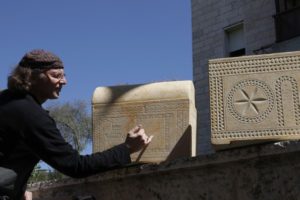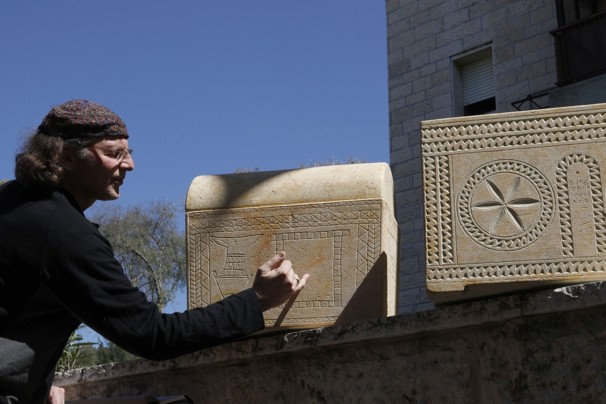Media Relations and Popular Archaeology
 I just got back from the annual SBL and AAR conference which took place in Chicago this year. For those who don’t know, SBL is the Society of Biblical Literature and AAR is the American Academy of Religion. It’s a huge conference that happens once a year, moving from city to city in North America (http://www.sbl-site.org/). I believe that some ten thousand individuals, mostly scholars, attended the conference this year which took place at the McCormick Convention Center. I had the honour of being invited to speak on a panel on “media and archaeology” (see program description below). Because it was originally programmed for the Sabbath – which I can’t do – and then moved to Sunday, we lost some of our audience but for those who came it was an important – perhaps historic – session. Why historic? Because I believe it was the first time that a filmmaker/academic participated in the session within the confines of the SBL.
I just got back from the annual SBL and AAR conference which took place in Chicago this year. For those who don’t know, SBL is the Society of Biblical Literature and AAR is the American Academy of Religion. It’s a huge conference that happens once a year, moving from city to city in North America (http://www.sbl-site.org/). I believe that some ten thousand individuals, mostly scholars, attended the conference this year which took place at the McCormick Convention Center. I had the honour of being invited to speak on a panel on “media and archaeology” (see program description below). Because it was originally programmed for the Sabbath – which I can’t do – and then moved to Sunday, we lost some of our audience but for those who came it was an important – perhaps historic – session. Why historic? Because I believe it was the first time that a filmmaker/academic participated in the session within the confines of the SBL.
The fireworks began when Prof. Robert Cargill used his entire 20 minute speech to criticize my work. According to Prof. Cargill, there is legitimate and illegitimate debate. Illegitimate debate about archaeology occurs when a filmmaker like me is told by the academy that his conclusions are wrong and he continues with his hypotheses without listening to the academy. According to this analysis, at that point, historical “fact” is separated from historical “fiction”. The former represents the opinions of academics, the latter my opinion. Furthermore, with this analysis, Prof. Cargill justified a personal attack on me. Basically, he said, if I’m peddling historical fiction as historical fact, since I’m not stupid, the only motivation must be money. After putting me in the company of people with various aliens theories, he rested his case by pointing out how outrageous my claims have been over the years i.e., that Atlantis has been found, that the tomb of Jesus has been found, that the earliest Christian icon was identified by my colleagues and me, and that even the nails that crucified Jesus have been identified. He took special care to point out that the latter are small nails that could not have been used in anyone’s crucifixion.
In the rebuttal, I pointed out that there are two kinds of journalists – reporters and investigators. Investigators, by definition, investigate. American presidents, for example, are used to being cross-examined but scholars are not. As a result, people like Cargill retaliate with personal attacks. My film, “Finding Atlantis” for National Geographic, focused on a team of Spanish archaeologists and American and Canadian archaeologists who investigated the mudflats of Doñana in southern Spain. It has been hypothesized for decades that what Plato calls Atlantis is what the Bible calls Tarshish and historians call Tartessos. All three seem to have disappeared suddenly and all three seem to have been located in southern Spain. As for the nails, I pointed out that it was Prof. Israel Hershkovitz, head of forensic anthropology at Tel Aviv University, that says that they are crucifixion nails. The possibility that they are the nails used in Jesus’ crucifixion arises out of the fact that they were found in the coffin (!) of the High Priest Caiaphas, who sent Jesus to the Romans who then sent him to the cross. Finally, if you can find the tomb of Caiaphas, why can’t you find the tomb of Jesus, I asked. The objection seems to be theological, not scientific. As for being alone with all these so-called kooky theories, the fact is that Prof. James Tabor also believes that the tomb of Jesus has been found in Talpiot, south of the Old City of Jerusalem. Prof. James Charlesworth believes that the tomb belongs to Jesus’ family, but not Jesus. The late Prof. Jane Schaberg believed that this tomb belongs to the earliest followers of Jesus. Meaning, I’m not alone. When it comes to the “Jonah” image that we discovered last year in Jerusalem, it is the earliest Jesus related icon ever discovered. And I’m not the only one who believes this. It’s true that many say that we identify as a fish is really a vase, but Prof. Rami Arav says it’s a fish, so does Prof. Tabor, so does Prof. Charlesworth, so does Dr. Yuval Baruch and so does Prof. Rachel Hachlili. The sad thing is that people like Prof. Hachlili have refused to get involved in the debate because of personal attacks such as the one mounted by Prof. Cargill.
In the Q&A, Prof. Rami Arav and Prof. Richard Freund objected to Prof. Cargill’s use of “fact” and statement that all academics oppose me. Prof. Cargill then stated that the “majority” of academics disagree with me, at which point Professors Arav and Freund pointed out that truth has never been decided by majority vote, at least not in science. After this, Prof. Cargill toned down the critique. He said that what I do is “very important,” at least from the point of view of exciting students and involving them in archaeology. It was agreed by one and all that this debate was necessary, at least to air out the differences. In a personal conversation with Prof. Goodacre and Prof. Cargill, I said that I don’t mind the criticisms. I think a good debate is healthy and it’s the only way to get to the truth. What I mind is the personal attacks. I got the impression that this session will lead to an atmosphere of friendly debate rather than acrimonious attacks. The fact is that the media can re-engage millions of people in the stories of the Bible, specifically in the archaeology of the Bible. That’s a good thing. Journalists have different standards than academics. Not lower standards, just different standards. There’s no reason for recrimination, but there are lots of reasons for cooperation.
S17-307
SBL Blogger and Online Publication Section Theme: Media Relations and Popular Archaeology Sunday, 1:00 PM–3:00 PM MPW-474B
This is a special session with filmmaker Simcha Jacobovici and James Tabor discussing archaeological claims and the role the popular media plays with scholarship. Christopher Rollston and Robert Cargill will join Jacobovici and Tabor to discuss the role of popular media in scholarship.
Christian Brady, Pennsylvania State University, Presiding

